Employment
Last Modified 01/06/2022 16:17:23
Share this page
Employment
Introduction
This page provides a brief overview of Blackpool Labour Market statistics. For further information please see NOMIS, the Office for National Statistics Official Labour Market Statistics website.
Facts and Figures
Overall Labour Market Supply
Supply in the labour market is defined as the availability of people and skills that can fill the roles demanded by employers.
Figure 1: Blackpool Economic Activity, Employment and Unemployment Estimates, Jan 2021 to Dec 2021
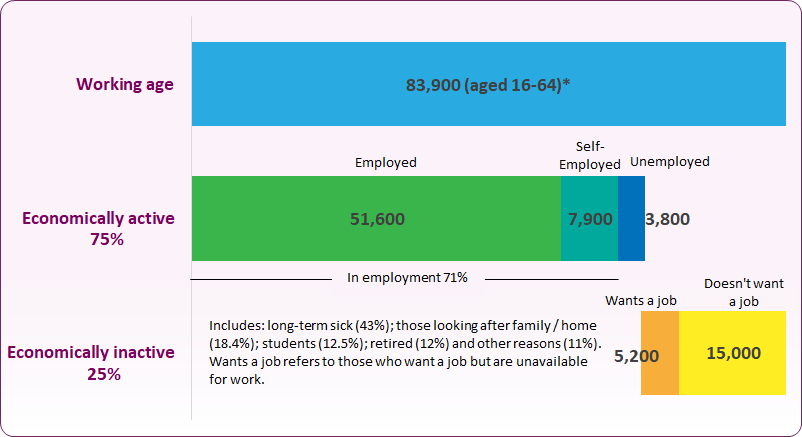
Source: NOMIS / ONS Annual Population Survey, Jan 2021-Dec 2021. * Note: Above numbers are for those aged 16 years and above, whilst percentages are for those aged 16-64.
For the period January 2021 to December 2021:
-
- The employment rate in Blackpool was 71% - made up of those currently working or self-employed. This is lower proportionally than both the North West (72.9%) and Great Britain (74.8%)
- Unemployment - essentially those actively seeking employment but currently not in a job - is around 6% of those economically active in Blackpool. This is higher than Great Britain (5.9%) and the North West (4.6%)
- Economic inactivity refers to those who are not available for work, or who do not want to work. Blackpool, at 25%, has a higher proportion of economically inactive individuals than Great Britain (21.6%) and the North West (23.5%)
- Long Term Sickness accounts for 43% of all economically inactive in Blackpool. This is a substantially higher proportion than those economically inactive in both Great Britain (24.6%) and the North West (27.5%)
This reporting period is affected by the Covid-19 pandemic, with economic shutdown of some parts of the economy and the Coronavirus Job Retention Scheme (CJRS), or furlough scheme, operating between March 2020 and 30th September 2021 to provide financial support for companies and employees. Nationally, the number of people on furlough peaked at 8.9 million (May / June 2020 lockdown period) and 1.3 million employers benefitted from the scheme. In 2021 the number of people furloughed reduced steadily after the opening of retail outlets from 12th April and the lifting of all restrictions on 19th July. Not all jobs were protected during this period, however, and an estimated 1 million people were made redundant nationally between April 2020 and June 20211. In Blackpool 20,900 'employments' were furloughed in the period up to August 2020, representing 36% of those eligible. In January 2021 this figure was 11,100 (20% of eligible), falling to 2,100 (4%) at the end of the scheme2.
Employment rate trend data reflects the impact of the pandemic (Figure 2). Employment rates in Blackpool had been climbing steadily since late 2017 (69.6%) to a peak of 74.9% for the period July 2019 to June 2020, before falling to the current level of 71% (a sharper decrease than seen nationally or regionally). Unemployment rates among those aged 16-64 also increased from a low of 3.7% for the October 2019 to September 2020 period to the current level of 5.3%. Whilst increases in unemployment were also seen nationally and regionally, rates for other areas appear to be recovering more rapidly than in Blackpool. Similarly, the proportion of those economically inactive rose from 21.8% between July 2019 and June 2020 to 25% between January and December 2021.
Figure 2: Employment rate trends, 2011 to 2021: Blackpool, Great Britain and North-West (quarterly 12-month rolling data)
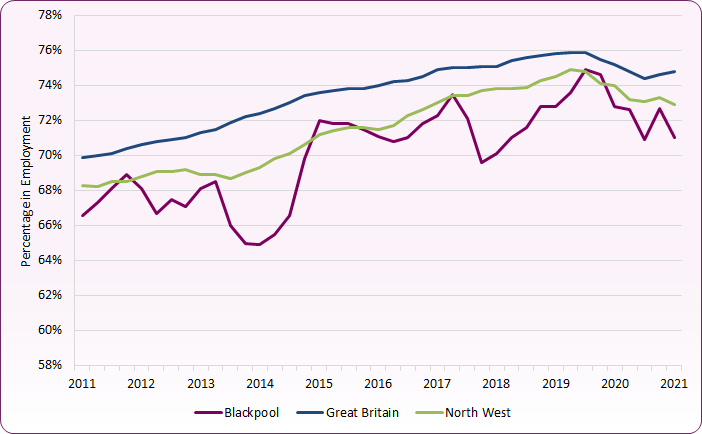
Source: NOMIS / ONS Annual Population Survey
Employment by Occupation
Figure 3 shows the number and proportion of those employed across Standard Occupational Classifications (SOC 2010) in Blackpool. 40.3% of those employed in Blackpool are within occupational groups 6-9, compared to 34% in the North West and 31.3% across Great Britain. Unsurprisingly, a higher proportion work in caring, leisure and other services (14.4%) compared to the North West (9.5%) and great Britain (9.2%). Proportions of those employed as managers, directors and senior officials; those in professional occupations; and skilled trade occupations are lower than regional and national levels.
2020 data from the ONS Business Register and Employment Survey (via NOMIS) identified that 25% of jobs in Blackpool are within the Human Health and Social Work industry (13.6% nationally), with 14.1% in wholesale and retail trade & motor vehicle repair (14.9% nationally), 12.5% in public administration and defence & compulsory social security (4.6% nationally) and 10.9% in accommodation and food services activity (7.2% nationally).
Figure 3: Employment by Occupation, Blackpool, North West and Great Britain, 2021
| | Blackpool (n) | Blackpool % | North West % | Great Britain % |
|---|
| SOC 2010 Major Group 1-3 |
24,400 |
41.0 |
46.8 |
49.7 |
|---|
| 1 Managers, Directors & Senior Officials |
5,200 |
8.7 |
9.6 |
10.5 |
|---|
| 2 Professional Occupations |
10,300 |
17.3 |
22.5 |
23.7 |
|---|
| 3 Associate Professional and Technical |
8,900 |
15.0 |
14.6 |
15.3 |
|---|
| SOC 2010 Major Group 4-5 |
11,200 |
18.8 |
19.2 |
19.0 |
|---|
| 4 Administrative & Secretarial |
6,500 |
11.0 |
10.4 |
10.2 |
|---|
| 5 Skilled Trades Occupations |
4,700 |
7.8 |
8.8 |
8.8 |
|---|
| SOC 2010 Major Group 6-7 |
13,800 |
23.2 |
17.5 |
16.2 |
|---|
| 6 Caring, Leisure and Other Services |
8,600 |
14.4 |
9.5 |
9.2 |
|---|
| 7 Sales and Customer Services |
5,200 |
8.7 |
7.9 |
6.9 |
|---|
| SOC 2010 Major Group 8-9 |
10,200 |
17.1 |
16.5 |
15.1 |
|---|
| 8 Process Plant & Machine Operatives |
3,200 |
5.4 |
5.9 |
5.5 |
|---|
| 9 Elementary Occupations |
7,000 |
11.7 |
10.5 |
9.6 |
|---|
Source: NOMIS / ONS Annual Population Survey, Jan 2021-Dec 2021
Out-of-Work Benefits
The main benefit available for those who were unemployed but able and available for work was Job Seekers Allowance (JSA) up to November 2014. From this date Universal Credit started to replace a number of benefits including:
- Child Tax Credit
- Housing Benefit
- Income Support
- Income-based Job Seeker's Allowance (JSA)
- Income-related Employment and Support Allowance (ESA)
- Working Tax Credit
Under Universal Credit a broader span of claimants are required to look for work than under Job Seekers Allowance. As the Universal Credit Full Service is rolled out the number of people on the Claimant Count is expected to rise.
At the end of the November 2021 quarter (latest available figures at time of reporting) there were 21,387 Blackpool residents on some form of out-of-work benefits (including those on incapacity benefits and not expected to work due to ill-health or caring roles)3:
- 6,886 people on some combination of Employment and Support Allowance, Incapacity Benefit, Severe Disablement Allowance or Income Support on the basis of incapacity
- 13,466 on Universal Credit (Out of work or no work requirements): searching, planning or preparing for work, or not expected to work at present (Health or caring responsibilities prevent claimant from working)
- 368 on Universal Credit (as above) with some combination of incapacity-based allowance
- 334 on Jobseeker's Allowance
- 174 on Income Support
- 140 on Pension Credit out-of-work
- 13 on Universal Credit and Jobseeker's Allowance
Figure 4 shows the proportion of JSA and unemployment-related Universal Credit claimants (those who are required to seek and be available for work) between January 2004 and March 2022. The 2008 recession sharply increased unemployment, and the further increase in 2011-12 is partly due to austerity measures taking effect on public sector employment. Following a peak of over 6,000 claimants (7.1% of the 16-64 resident population) in late 2012 / early 2013, figures returned to almost pre-recession levels by 2016. It is, however, noteworthy that national and regional claimant rates fell to below-recession levels during this period, suggesting that Blackpool's employment market recovered less well than other areas.
The effects of the seasonal labour market can also be seen in the chart, with differences between September and February claimant rates of around 1%, though claimant peaks and troughs were more shallow in the post-recession period between 2015 and 2019.
Whilst the number and rate of unemployment-related claimants in Blackpool was rising more sharply than national and regional levels prior to the pandemic, the impact of Covid-19 can clearly be seen in claimant figures from March / April 2020 onwards. The number of Blackpool claimants rose from 5,940 (7.1%) in February 2020 to 10,375 (12.4%) in July 2020 at the start of the first lockdown period. Falling slightly between September to December, claimant levels roles again around the second lockdown, peaking at 10,510 (12.5%) in February 2021.
Since the easing of lockdown restrictions, unemployment-related claimant rates have fallen to the March 2022 level of 7,145 (8.5% of the resident 16-64 population or 11.4% of the economically active adult population). This is still higher than pre-pandemic levels and double the national rate for Great Britain of 4.2% of the resident population (5.2% of the economically active population).
Figure 4: Proportion of Unemployment-Related Claimants (16-64 population): Blackpool, North West and Great Britain, month-by-month January 2004 to March 2022
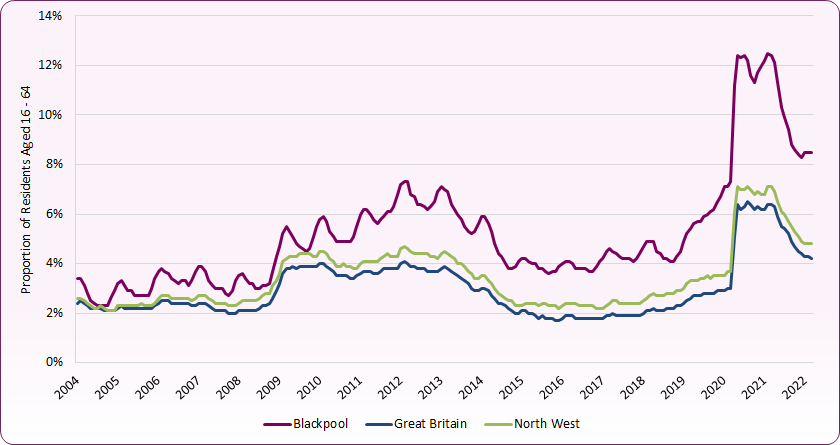
Source: NOMIS / ONS Claimant Count by sex and age
The proportion of unemployment-related claimants aged 16 to 24 fell gradually from around 2010 until 2019, whilst the number and proportion of those aged over 50 increased (Figure 5). This also reflects a national shift towards middle and older age group claimants in recent years. Based on March 2022 data, 27% (1,945) of Blackpool's claimants were aged 50 and over, compared to 24% across Great Britain and 22% in the North West. 57% (4,070) were aged 25 to 49 compared to 60% nationally and regionally. The fall in the overall proportion of unemployment-related claimants aged 16 to 19 may have been impacted by changes to the school leaving age between 2013 and 2017, though current claimant numbers for those aged 16 to 24 (1,125 in March 2022) are similar to 2013/14 levels.
Figure 5: Proportion of Blackpool Unemployment-Related Claimants by Age, 2004 -2022
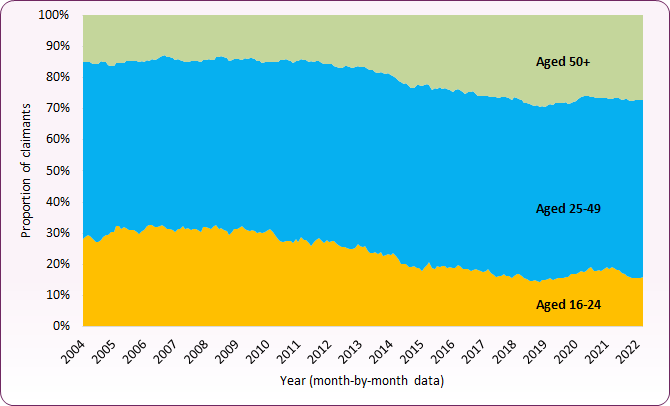
Source: NOMIS / ONS Claimant Count by sex and age
The number and rate of male unemployment-related claimants is consistently higher than for females in Blackpool, though this gap narrowed between 2015 and the start of the pandemic (Figure 6). In March 2022 there were 4,505 male claimants (10.7% of the 16-64 population) and 2,604 female claimants (6.3%). This compares to 4.9% male claimants and 3.5% female claimants across Great Britain. Between February 2020 and May 2020 (initial Covid-19 period) claimant numbers increased by 82% for males and 66% for females.
Figure 6: Blackpool Unemployment-Related Claimants for Males and Females, 2004-2022
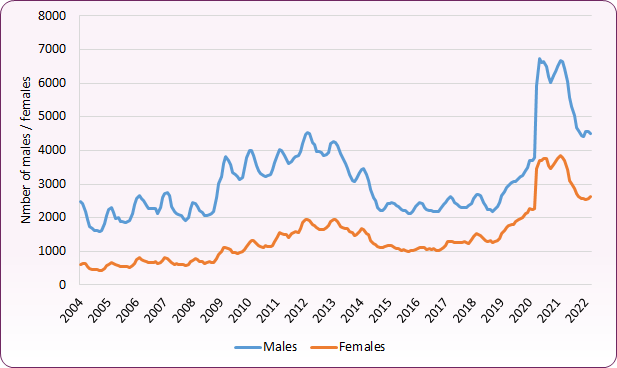
Source: NOMIS / ONS Claimant Count by sex and age, 2004 to March 2022
Universal Credit - Conditionality
Universal Credit involves a 'conditionality' element, where a claimant may have to undertake certain activities (conditions) in order to get full entitlement. Each person is assigned one of six conditionality regimes based on their assessed capability and circumstances.
Of the 21,312 people on Universal Credit (including both those in and out of employment) in Blackpool in March 20223:
- 6,697 (31.4%) were searching for work, either currently not working or with very low earnings
- 6,456 (30.3%) were not expected to work at present - with health or caring responsibilities preventing them from working
- 3,459 (16.2%) were working with requirements - in work but could earn more, or not working but with a partner on low earnings
- 3,247 (15.2%) were working with no requirements - with individual or household earnings over the level that conditionality applies
- 1,049 (4.9%) were preparing for work - expected to start preparing for work, with a limited capacity for work at the present time or a child aged two
- 403 (1.9%) were planning for work - lone parents or lead carers of children aged one
13,190 (61.9%) of all Universal Credit claimants were identified as 'not in work' during the Universal Credit assessment period, compared to 59% across England and Great Britain. Of these, 5,658 (42.9%) had no work requirements and were not expected to work at present, 5,527 (41.9%) were searching for work, and 1,199 (9.1%) were planning or preparing for work at the March 2022 count date.
Employment and Support Allowance (ESA)
Employment and Support Allowance replaced Incapacity Benefit in 2008. It provides financial support for people who have limited capability for work due to sickness or disability but do not receive Statutory Sick Pay. Applicants are assessed on their capacity for work, usually through both a questionnaire and a medical assessment. If the Department for Work and Pensions (DWP) determines the applicant has limited capability for work, they are placed in one of two groups:
- Work-related activity group - required to carry out activities to prepare for returning to work
- Support group - not required to carry out any activities
Following the Welfare Reform Act 2012, ESA comes as two separate benefits:
- Income-related Employment and Support Allowance - this is being phased out and replaced by Universal Credit and new claims are only possible in limited circumstances
- New-style Employment and Support Allowance - a contribution-based benefit based on National Insurance Contributions
New-style Employment and Support Allowance was also available up to March 24th 2022 for those who had to self-isolate or quarantine and were unable to claim Statutory Sick Pay.
At the quarter ending November 2021 (Covid-19 affected period):
- There were 7,203 Employment Support Allowance claimants in Blackpool.
- This is a 29% decrease from May 2018 (Figure 7). This reflects national reductions as a consequence of Universal Credit replacing ESA for new income-related claims on the grounds of incapacity. Blackpool's sharper rate of decline between November 2018 and May 2020 may be due to a higher proportion of cases with low income transferring to UC.
- 52.5% of claimants were male and 47.4% female, compared to 49.2% male and 50.8% female across Great Britain. The number of male claimants has been falling at a faster rate than female claimants.
- 85% of Blackpool claimants were within the 'Support Group' category compared to 82% nationally. 10% were in the 'Activity Group' and 3% in the assessment phase.
Figure 7: Employment and Support Allowance Caseload Rates (16-64 population) - Blackpool, North West and England, May 2018 to November 2021
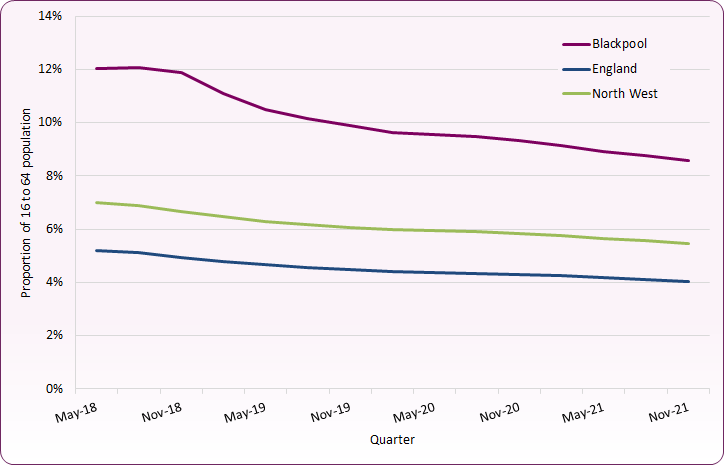
Source: Stat-Xplore, Department for Work and Pensions, May 2018 to November 2021 data.
Figure 8 shows the reasons for ESA claims from the Blackpool population. The majority of claims for ESA fall into the International Classification for Disease category of mental and behavioural disorders, which is a very wide spectrum covering disorders such as schizophrenia and personality disorder but also drug use, dementia and learning difficulties.
The group 'symptoms, signs and abnormal clinical findings' is also a high percentage and generally refers to groups who have not yet received a diagnosis.
Figure 8 - Reason for Employment and Support Allowance Claim: Blackpool, 2021
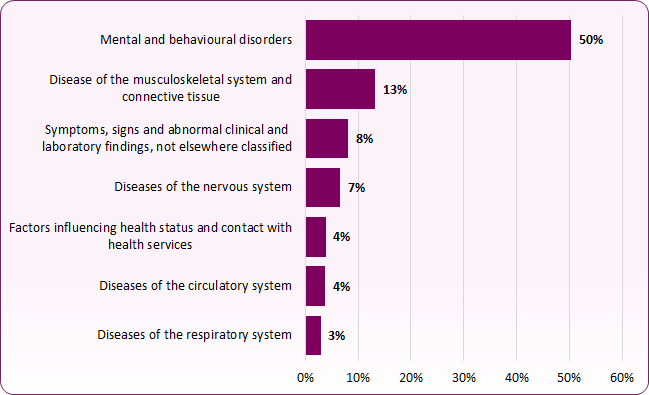
Source: Stat-Xplore, Department for Work and Pensions, November 2021 data.
Lone Parents
Lone parents are amongst those vulnerable groups at greatest risk of unemployment due to the demands of balancing working and home life, especially with younger children. Two thirds of all children in poverty are from lone parent families.
Across England between October and December 2021 the employment rate of lone parents was 67.7% compared to 83.3% for all those with dependant children. For lone parents with children aged 0 to 2 years old the employment rate was 43% (compared to 83.9% for parents in a couple). The rate for those with children aged 3 to 4 years old was 57.2%, 72.9% for 5 to 10 year olds, and 77.4% for 11 to 15 year olds4.
The number of Blackpool lone parents claiming Income Support has fallen since February 2009, when there were 2,471 claimants, to November 2021, when there were 361 claimants. The introduction of a range of lone parent obligations from 2008 onwards, and changes as a consequence of the Welfare Reform Act, led to reductions in child entitlement ages to the point that from May 2012 lone parents could only claim Income Support until their youngest child was aged five years old, they were working less than 16 hours per week, had earnings of less than £16,000 and were living on a low income (or without an income). Those affected by the reductions to the child age limit tended to claim Jobseeker's Allowance.
More recently, Universal Credit has replaced individual benefits such as Income Support and Jobseeker's Allowance for many, though the migration from 'legacy benefits' continues. Lone parents are able to claim Universal Credit on the conditions similar to the previous Income Support, and how much is received depends on circumstances and the number of children (though in most circumstances a parent can only claim for the first two children). In November 2021 there were 4,917 households claiming Universal Credit in Blackpool who identified as being single with children (31% of all households claiming UC in Blackpool compared to 35% in England)3. This does, however, include all households for Universal Credit, and is not a measure of those not in employment.
[] House of Commons Library. Examining the end of the furlough scheme, 15th November, 2021.[] HMRC Coronavirus (COVID-19) statistics: Coronavirus Job Retention Scheme.[] Department for Work and Pensions, Stat-Xplore: Benefit Combinations, Quarterly data November 2021. NB. Count taken on second Thursday of each month[4] Office for National Statistics (ONS), Employment rate of parents living with dependent children by family type and age of the youngest child in the UK, March 2022.